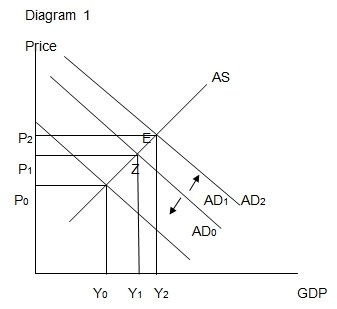Fiscal Policy
Fiscal policy refers to “the government spending policies that influence macroeconomic conditions” (Mankiw, 2002, p. 89). Such polices have a direct impact on tax rates, interest rates as well as government expenditure. The two instruments used in the implementation of fiscal policy include taxation and government expenditure. The use of the two instruments involves manipulating the level of government spending and or tax collection in order to influence the aggregate demand and the level of activity in the economy.
Shifts in Aggregate Demand
Diagram 1

- P: price;
- Y: national income;
- AS: aggregate supply;
- AD: aggregate demand.
In diagram 1, the aggregate demand curve shifts to the right from AD1 to AD2 as a result of fiscal policy changes such as increase in government spending and or a reduction in tax rates. The shift causes an increase in GDP from y1 to y2 alongside price increase from p0 to p1.
A decrease in tax rate leaves the citizens with a greater disposable income and the resulting increase in their purchasing power leads to an increase in aggregate demand. Increase in government expenditure causes an increase in aggregate demand due to the fact that it involves spending in both capital and consumer goods (Mankiw, 2002, p. 102).
The aggregate demand curve shifts to the left from AD1 to AD0 due to fiscal policy changes such as a reduction in government spending and or an increase in tax rate. The shift causes national income to reduce from y1 to y0 and a fall in prices from p1 to p0.
Effectiveness of the Policy
A shift in aggregate demand is achieved through an expansionary or a contractionary fiscal policy. An expansionary fiscal policy is associated with crowding-out effect and a reduction in exports (Mankiw, 2002, p. 136).
Crowding-out effect limits private investments as interest rates rise due to government borrowing. The high interest rates lead to massive capital inflows and appreciation of domestic currency. Thus exports become more expensive and their demand reduces.
Australia’s Fiscal Policy Stance
In the 2010/11 budget the government intends to increase its expenditure and to lower taxes in order to stimulate economic growth and to ease the cost of living. Those receiving salaries of up to $30,000 will now benefit from a tax free threshold as high as $16,000. The 30% tax rate will now be charged on earnings beginning from $ 37,001 instead of $ 35,001(Australian Government, 2011).
Those whose earnings range between $ 80,000 and $ 180,000 will pay income tax at 37% instead of 38%. The government will also invest $1billion in infrastructure, $661.2 million in creating new skills and $ 2.2 billion in health care (Australian Government, 2011). The increase in government spending and reduction is taxes indicate that the government’s fiscal policy stance is expansionary.
Inflationary Pressures
The June 2011 inflation report reveals that inflation increased by 0.9% (Australian Bureau of Statistics, 2011). The increase in inflation was mainly caused by an increase in prices of consumer goods such as foodstuff and personal accessories.
Effectiveness of the Fiscal Policy Stance
The tax cuts will leave the citizens with more disposable income which translates into high purchasing power and a rise in aggregate demand. Increase in government spending will also increase aggregate demand. The increase in aggregate demand results into economic growth but at a high price (inflationary) (Mankiw, 2002, p. 160). Since the economy is operating at under capacity, the expansionary fiscal policy is likely to cause a rapid economic growth which encourages more private investments. Thus the fiscal policy stance is effective.
References
Australian Bureau of Statistics, 2011. Australia Inflation Rate. Web.
Australian Government, 2011. Budget 2010-11. Web.
Mankiw, G. 2002. Macroeconomics. Worth Publishers.